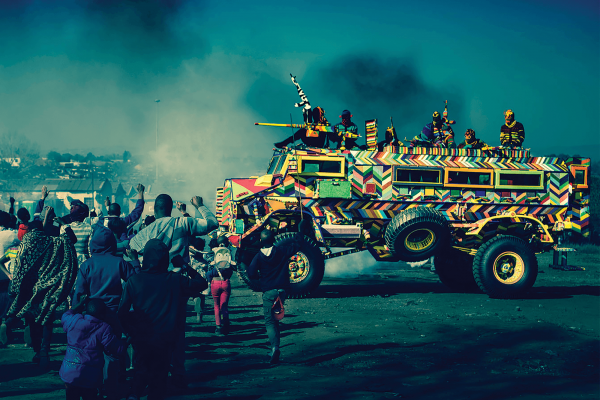HANNAH ARENDT SAID we can ask of life, even in the darkest of times, a “redemptive element,” and art can be that—an affirmation of right, light, truth, some beleaguered beauty. But note well: Art is no escape from the problems of the world but, rather, a repurposing, a resistance. And, of course, this phenomenon of violence into art can go both ways. Michelangelo’s bronzes, including his colossal papal statue of Pope Julius II, were melted down into cannons and other weapons during the French Revolution. It’s our choice.
Here are four artists who chose to turn trauma—civil war, natural disasters, apartheid, and female genital mutilation—into sights to behold.
Ralph Ziman, South Africa
Designed and put into service in apartheid South Africa in the 1980s, the so-called Casspir, a mine-resistant and ambush-protected vehicle, has been subverted. Says South African artist Ralph Ziman: “The Africanization of the Casspir seemed to take away the terror it once evoked ... people felt comfortable to approach it, touch it, and share their stories and memories.” He elaborates on his intention: “To make this weapon of war, this ultimate symbol of oppressing ... to reclaim it, to own it, make it African, make it beautiful, make it shine.”
Born in South Africa in 1963, Ziman grew up in a strict system of institutionalized racial segregation and political and economic discrimination—“apartheid,” which translates in Afrikaans to “apartness.”
“I have vivid memories,” he says of his first sighting of a Casspir. It was April 1993. Charismatic leader Chris Hani had been gunned down outside his house in a Johannesburg suburb by a white nationalist. The artist drove to the funeral and saw columns of Casspirs descending the dusty streets; heavily armed police fired tear gas, shotguns, and automatic weapons. More of the same occurred the next day in Soweto, where police and army units parked their Casspirs along the highway and exchanged gunfire with members of the African National Congress. “Tear gas and smoke burned our eyes and into our memories, along with the sight of armed men on the Casspirs ... for me, covering this beast with beads is catharsis,” says Ziman.
Read the Full Article

